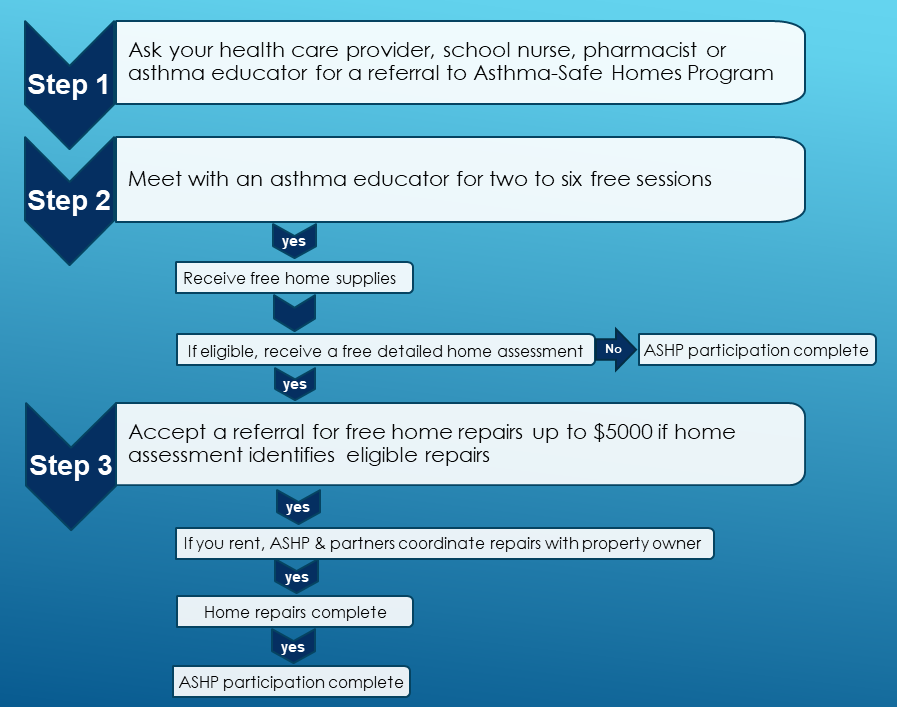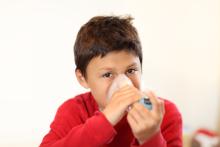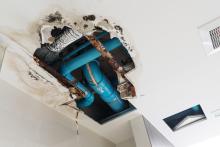Asthma-Safe Homes Program: Overview for Families with Asthma
Participating in the Asthma-Safe Homes Program
If you or your child has asthma, learn more about how to participate in the Asthma-Safe Homes Program.
Here's a visual chart that shows the steps to participate in the Asthma-Safe Homes Program.
Steps to participate in the Asthma-Safe Homes Program
Step 1: Ask your health care provider, school nurse, pharmacist or asthma educator for a referral to Asthma-Safe Homes Program.
Step 2: Meet with an asthma educator for two to six free sessions. ⇒ Yes ⇒ Receive free home supplies. ⇒ If eligible, receive a free detailed home assessment. ⇒ No ⇒ Asthma-Safe Home Program complete
Step 3: Accept a referral for free home repairs up to $5,000 if home assessment identifies eligible repairs. ⇒ Yes ⇒ If you rent, the Asthma-Safe Home Program and partners coordinate repairs with property owner ⇒ Yes ⇒ Home repairs complete ⇒ Yes ⇒ The Asthma-Safe Homes Program participation is complete.
To be eligible for the Asthma Safe Homes Program, you or your child must be:
- A child between 2-18 years old.
- A pregnant parent.
- Living in Milwaukee, Kenosha, Racine, Rock, or Brown counties.
- Currently enrolled or eligible to enroll in Medicaid state health insurance.
- Experiencing symptoms from poorly controlled asthma, which will be assessed during the program intake.
Once enrolled, clients will receive the following services:
- Two to six home visits and two additional follow-up sessions with an asthma educator. During the home visits the asthma educator will provide:
- Education on how to manage your or your child’s asthma.
- A home walkthrough to check for asthma triggers.
- A possible referral for home repair services if your home qualifies.
- Free products valued up to $1,000 that can help reduce asthma triggers in the home. Products may include dust mite covers for pillows and mattresses, asthma-friendly cleaning kits, vacuums with HEPA filters, home air cleaners, air conditioners, dehumidifiers, and more.
- If your home qualifies for repair services, you will receive:
- A detailed home assessment by a trained home assessor.
- Repair services up to $5,000 approved by the property owner to address asthma triggers, such as mold cleanup, carpet removal, or pest control.
There are many benefits to participating in the Asthma-Safe Homes Program, including:
- Learning how to better control your asthma through free asthma education.
- Receiving recommendations on how to address home asthma triggers and, if eligible, receiving a free detailed home assessment and free home repairs.
- Accessing free products to reduce home asthma triggers.
- Improving asthma outcomes and quality of life.
- $aving money through fewer missed days of work and school, reduced medication use, fewer trips to emergency room or urgent care clinic, and fewer overnight stays at the hospital.
These services are covered by Medicaid state health insurance at no cost to you.
If you believe you or your child is eligible for the program and you’re interested in participating, please contact the Asthma-Safe Homes Program education provider in your area.
For general questions, contact the Asthma-Safe Homes Program at DHSAsthmaSafeHomes@dhs.wisconsin.gov.
Check out the following resources to learn more about how to successfully manage asthma and create an asthma-friendly home.
- Allergy and Asthma Network – Find answers to your questions and concerns to minimize asthma and allergy symptoms and prevent flare-ups.
- Asthma and Allergy Foundation of America– Information and resources from the leading national nonprofit organization for people with allergies and asthma.
- CDC (Centers for Disease Control and Prevention) Healthy Schools – Information and resources on how to manage your child's asthma at school.
- Asthma Care: Your Guide to Managing Asthma, P-02168 (PDF)
- Healthy Homes: Keep your Homes Safe and Healthy
Questions? E-mail the Asthma-Safe Homes Program at DHSAsthmaSafeHomes@dhs.wisconsin.gov or call 608-266-1112.





